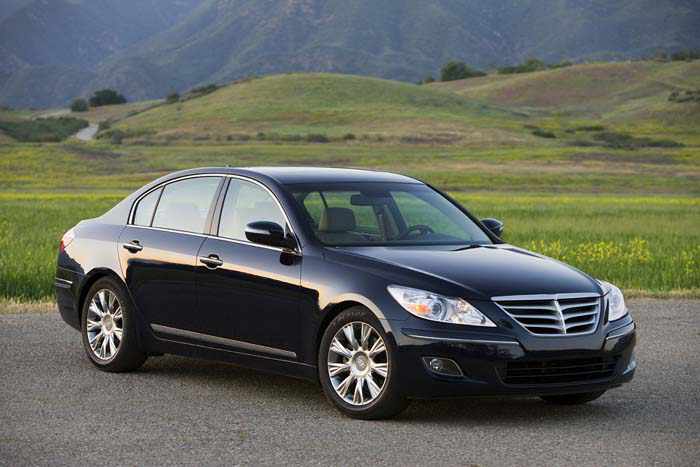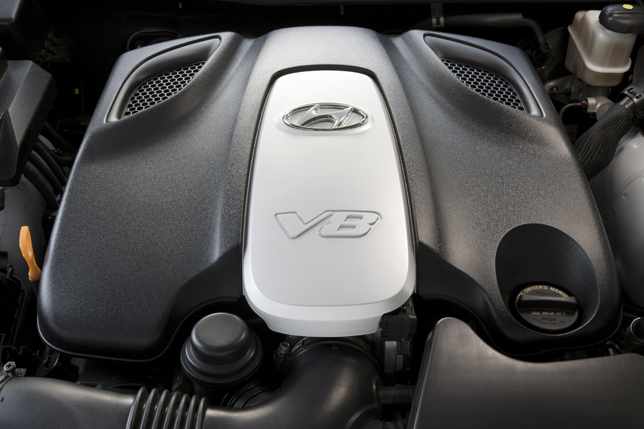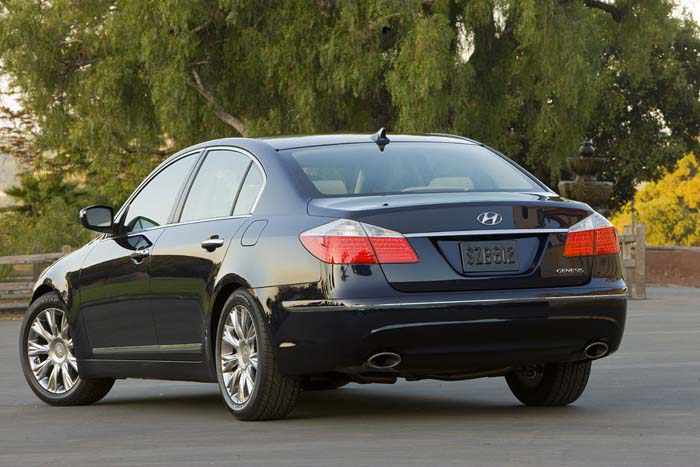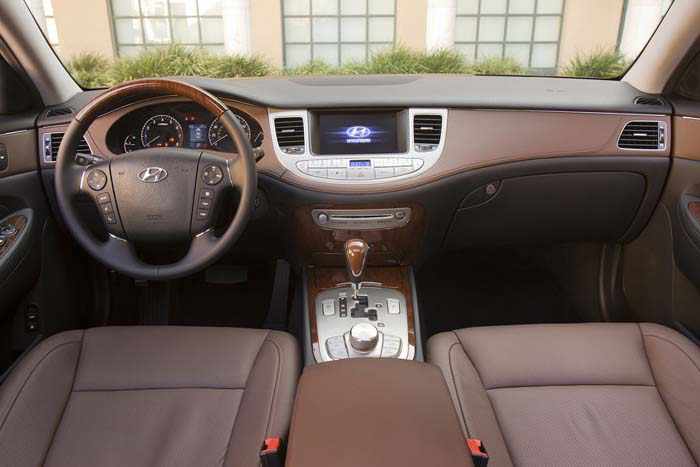
The 2009 Hyundai Genesis has been getting praise left, right, and centre from the media. It has already garnered the 2009 AJAC Canadian Car Of The Year as well as the North American Car of the Year. Impressive for a company that is still remembered for entering the North American market with the much-maligned Pony. Hyundai is certainly on a roll right now in terms of both product and sales (they are one of the few companies experiencing real growth in the rapidly-contracting NA market). The Hyundai Genesis represents the first time that the Korean manufacturer has sold a rear-wheel-drive platform for our market. The Genesis name is available on the back of a sporting coupe aimed at the Camaro/Mustang/370Z, as well a sedan that competes in the luxury segment against the S-class/7-series/LS models. Now, CarEnvy.ca has tested the fully-loaded sedan with the 375 hp 4.6L “Tau” V8 and the Tech Package.
Follow the jump for the unfiltered driving impressions.

Let’s start with the ZF-sourced transmission because this singular feature left the biggest impact on me. I’m trying to think of a way to be PC about this, but the transmission was so bad that it doesn’t deserve to be mentioned in the same sentence as the Tau engine. But it wasn’t just the tranmission that was lacking, it was also the driver’s connection to the tranmission, i.e. the gas pedal. The gas pedal was set up more strangely than any other I’ve ever used. At low speeds, it was far too touchy and would lead to excessively aggressive starts from a stop. The Twilight Zone really opened up when you tried to nail the throttle – the gas pedal has two pressure points! You can depress the go pedal 90% of the way and only get 70% of the power, but you can also “click” the pedal that extra 10% to get the extra 30% power. This invariably leads to poor modulation and the inability to control power between 70% and 100%. This extra stab of power causes the transmission to bounce off the rev-limiter for far too long before leisurely shifting down. It really is a confusing set-up and pretty much ruined my attempts at spirited driving.
The Tau engine, despite the transmission’s efforts to neuter it, was phenomenal. It’s not hard to see how the Tau engine made its way onto the venerable Ward’s 10 Best list. Between buttery power delivery and a great sountrack that only appeared when you wanted it, the Tau is a marvelous bit of kit. This also speaks to the commendable sound isolation of the Genesis sedan, which was at least as good as any Lexus we’ve reviewed here before.

So we’ve got a great engine lacking a tranny, but shouldn’t the engine alone be enough to make the car fun? Maybe if the tranmission was the only let-down. The other thing that put a damper on my attempts to have any fun in this car was the complete lack of lateral bolstering in the seats. Not that Edmonton has the windiest of roads, but on-ramps and off-ramps can usually provide plenty of fun. Not in the Genesis. Also, despite the nearly infinite adjustability of the seats, I couldn’t find an acceptable seating position relative to the pedals. The pedals always seemed too close and too upright, forcing my foot to dorsiflex like a bitch. In an aspirationally-labeled “luxury car”, this doesn’t quite cut the mustard.
The low-speed control was admirable even if the high-speed stuff wasn’t quite there. The steering felt direct and smooth around the parking lot, making the car feel smaller than its dimensions would suggest. This is a nice feeling in such a large vehicle because there’s no intimidation when parking.
The dimensions would suggest that this is a mammoth car and that it should compete with the S-class handily. So I went into the test drive expecting cavernous storage space. Unfortunately, the rear seats don’t fold down so you’re left with a fairly deep but not particularly wide or tall trunk. The trunk would be wider were it not for the hinges taking up so much space. Hyundai would have done well to take a look at the VW Phaeton’s sublimely engineered trunk hinges. There is a ski pass-through but fitting more than one set of golf clubs might be tricky and heading to Ikea is right out. Better to get a Honda Fit for that.

The sound system deserves its own article. What a masterpiece. For the uninitiated, the only other car featuring this Lexicon sound system is the $400,000 Rolls Royce Phantom. Seriously. I’m not sure how Hyundai snagged it, never mind how they fit it into a car costing $50,000. Must be nice to have bean-counters who allow for $10,000 sound systems. The multimedia centre, on the other hand, wasn’t the greatest. The control knob didn’t fit into my hand particularly well so I found myself hitting up when I was trying to hit down. At least there were six large buttons around the knob to expedite some of the navigation procedures. The last niggle about the mulitmedia centre was the large nav screen that should have been recessed into the dash a little more because its visibility really suffered when sunlight hit it.
The interior of the vehicle provided a sense of occassion for the driver that was not matched by the sense of occassion experienced by those watching the Genesis from the outside. The interior styling and quality wouldn’t have been terribly out of place in a Lexus and the same could be said of the exterior. The former is a compliment, the latter isn’t. It’s tough to conceive that such craftmanship and engineering prowess also produced the Hyundai Accent. Talk about a broad range of vehicles.
Speaking of a broad range of vehicles, one of my concerns is that the Genesis is too different from the other vehicles it shares the showroom floor with. The Genesis may be too good to act as a ”halo” product and may instead serve to shine light on the shortcomings of Hyundai’s other offerings.
I appreciate the difficulty and complexity in starting a luxury brand in the vein of Acura, Infiniti, and Lexus, but I can’t help but think it would have been worthwhile for the Koreans. The Genesis strikes me as the 1989 LS400 for the 21st century – high praise to be sure.
Instead of creating a new brand the way Lexus did, Hyundai seems to have chosen to use the Genesis as a warning shot across the bow of the established luxury manufacturers – a sign that one of the gloves is off and the other isn’t far behind. It’s no wonder Toyota is more worried about the Koreans than the Americans.
Price as tested: $48,995 + destination
Summary: The first glove is off.
Exterior Design: 5/10. Was Bertone so busy that it couldn’t help?
Interior Design: 6/10. Don’t get me started on the pedals and seats again…
Engine: 8/10. So smooth and silky you’ll forget it’s a Hyundai.
Transmission: 3/10. ZF should head back to the drawing board.
Audio/Video: 8.5/10. Sound was stunning but multimedia centre wasn’t polished.
Value: 9/10. This is what Hyundai is known for and it doesn’t let us down.
Overall (not an average): 6/10. Maybe all the awards inflated my expectations?
Special thanks to West End Hyundai of Edmonton.

